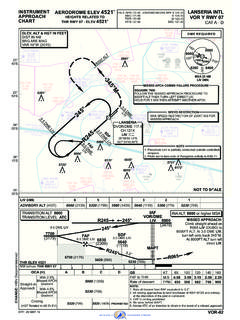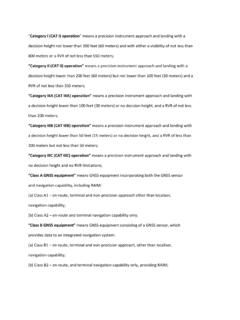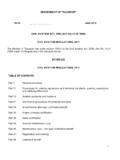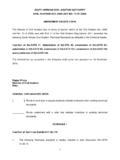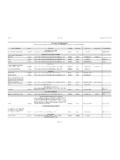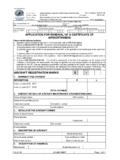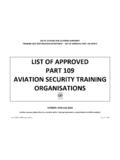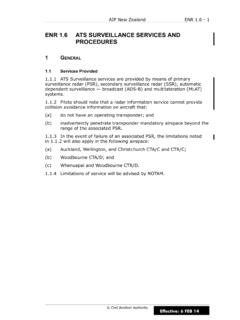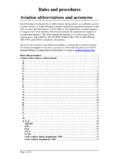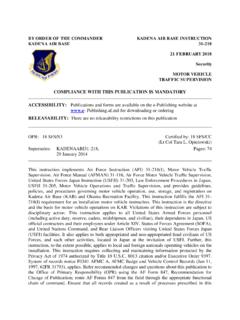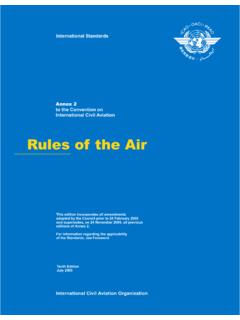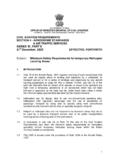Transcription of Section 2 Air Traffic Services - CAA
1 CAA standards & procedures (ATCIs) Manual - Section 2 Page 1 of 53 8 February 2013 Section 2 Air Traffic Services Chapter 1 Air Traffic Services 1 Introduction Air Traffic Services within the Republic of South Africa are provided in accordance with the Civil Aviation Regulations and Technical standards . Generally these are in line with the standards and recommended practices of the International Civil Aviation Organisation. The Civil Aviation Technical standards - Air Traffic Services - standards and procedures , contains standards and procedures to civilian controllers providing air Traffic Services . 2 Air Traffic Services Air Traffic service is a generic term meaning variously: a) Air Traffic control service; b) Air Traffic advisory service; c) Flight information service; d) Alerting service.
2 3 Objectives of Air Traffic Services The objectives of Air Traffic Services are to: a) Prevent collisions between aircraft; b) Prevent collisions between aircraft moving on the manoeuvring area and between aircraft and obstructions on the manoeuvring area; c) Expedite and maintain a safe and orderly flow of air Traffic ; d) Provide advice and information useful for the safe and efficient conduct of flights; e) Notify appropriate organisations regarding aircraft in need of SAR and to assist such organisations as required. The objectives of air Traffic Services as prescribed above do not include prevention of collision between aircraft in flight and terrain or obstacles thereon, so that the procedures prescribed do not relieve the pilot from the responsibilities for ensuring that any instructions or clearances issued by air Traffic Services are safe in this respect.
3 When an IFR flight is vectored by any means of ATS surveillance, air Traffic control is responsible for ensuring adequate terrain clearance. An air Traffic control service is provided according to the particular circumstances and class of airspace. It may comprise one or more of the following: CAA standards & procedures (ATCIs) Manual - Section 2 Page 2 of 53 8 February 2013 a) Aerodrome control service; b) Approach control service, with or without the aid of radar; c) Area control service, with or without the aid of radar. Safety and Expedition The provision of an air Traffic control or advisory service should be based upon expedition consistent with safety. In complex environments the benefits of deviating from basic procedures in order to expedite Traffic should be carefully considered against the extent of co-ordination required and the attendant risk of error.
4 The controller should deviate from the basic procedures only when he is quite sure that the resultant co-ordination can be carried out without excessive workload and without detriment to the safety of Traffic under his control. Where controllers are working together they should, whenever possible, pay attention to each other s actions in order to provide an additional safeguard against errors or omissions. 4 Airspace Organisation and Management All airspace within the borders of the Republic is the concern of ATM and is a useable resource. The ATM service provider, in conjunction with the SANDF is responsible for the flexible allocation and the usage of airspace based on the principles of access and equity. The airspace is organised and managed in a manner that will accommodate all current and potential new uses of airspace.
5 Airspace organisation and management will provide the first layer of conflict management. Effective airspace organisation and management will enhance the ability of the ATM service provider and airspace users to accomplish conflict management and also increase ATM system safety, capacity and efficiency. The airspace is organised to facilitate handling of flights and the ability for flights to be conducted along optimum flight trajectories from gate to gate without undue restriction or delay. 5 Combining Functions of an ATSU An ATSU may undertake one or more of the following ATS functions. Approach Control may be combined with Aerodrome Control, in which case the combined service will be identified by the call-sign of the TWR.
6 (Name of aerodrome)..Tower. Air Traffic Advisory Service or Flight Information Service may be combined with Area Control, in which case the combined service will be identified by the call-sign of the Area Control, name of city or sector. CAA standards & procedures (ATCIs) Manual - Section 2 Page 3 of 53 8 February 2013 Section 2 Air Traffic Services Chapter 2 Division of Airspace 1 General In order to facilitate the provision of air Traffic Services , the airspace is divided as detailed in the following paragraphs. Particulars of the various airspaces implemented within the RSA can be obtained from the SA-AIP. 2 Flight Information Regions Flight information regions are airspace s of defined dimensions within which flight information service and alerting Services are provided.
7 The RSA airspace is divided into three flight information regions (FIR). These being the Johannesburg FIR, Cape Town FIR and Oceanic FIR. ICAO Regional Meetings determine the boundaries of the FIRs in order to allocate responsibility for the provision of the ATS to specified States. States are expected to divide the airspace s within their FIRs into the following types of airspace as necessary for the efficient provision of the ATS to the expected air Traffic ; a) Controlled Airspace s; b) Advisory Airspace s; and c) Information Airspaces. Classification of Airspaces The classification of the airspace within a flight information region determines the flight rules which apply and the minimum Services which are to be provided. Note: Refer to SA-CATS for the classification of airspaces.
8 Controlled Airspace Aircraft operating in these airspaces are provided with full air Traffic control service in accordance with airspace classification. Controlled airspace is sub-divided into the following types: CAA standards & procedures (ATCIs) Manual - Section 2 Page 4 of 53 8 February 2013 Airspace Type Airspace Classification Exceptions a) Aerodrome Traffic Zone B, C, D or E b) Control Zone B, C, D or E c) Control Area B, C, D or E No VFR flights permitted above FL195. d) Terminal Control Area B or C e) ATS route B, C, D or E No VFR flights permitted above FL195. f) Oceanic A IFR only above FL245. Uncontrolled Airspace Advisory Airspace In advisory airspace all participating IFR flights receive an air Traffic advisory service and all flights receive flight information service if requested.
9 Information Airspace Air Traffic Control Service is not provided in uncontrolled airspace, only information useful to the safe and efficient conduct of flights is provided. Designated Uncontrolled Airspaces Aerodrome Traffic Zone Class G This includes the provision of Aerodrome Flight Information Service. Flying Training Areas These designated flying areas are indicated as danger areas on aeronautical charts and are described in the SA-AIP. Prohibited, Restricted or Danger Areas These are indicated on aeronautical charts and may intrude into or be encircled by Controlled or Advisory Airspace. Information Routes These are frequently flown routes through uncontrolled airspace and are shown on charts by a single line with the appropriate code letter of the route number and the letter F W86F.
10 Section 2 Air Traffic Services Chapter 3 ATS System Capacity and Air Traffic Flow Management CAA standards & procedures (ATCIs) Manual - Section 2 Page 5 of 53 8 February 2013 1 Capacity Management General The capacity of an ATS system depends on many factors, including the ATS route structure, the navigation accuracy of the aircraft using the airspace, weather related factors and controller workload. Every effort should be made to provide sufficient capacity to cater for both normal and peak Traffic levels; however, in implementing any measures to increase capacity the responsible ATM service provider shall ensure that the processes as contained in the Safety Management System are complied with and that safety levels are not compromised in any way.

